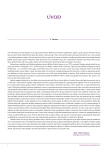Supraventricular arrhythmias in elite athletes
Authors:
M. Kozák
Authors‘ workplace:
LF MU a FN Brno, pracoviště Bohunice
; Interní kardiologická klinika
Published in:
Kardiol Rev Int Med 2007, 9(Mimořádné): 28-31
Category:
Editorial
Overview
Supraventricular arrhythmias in the athletes frequently are benign and may not even require therapy. However, they occasionally may be associated with more severe symptoms or cause hemodynamic collapse and require definitive treatment. An athlete with supraventricular tachycardia participating in potentially dangerous sports, such as diving, downhill skiing or auto racing may be at greater risk because of dizziness, near syncope. The search for significant structural heart disease is an important element in evaluating athletes with arrhythmias prior to sports participation. In the athletes, sustained supraventricular tachycardia is most commonly due to atroventricular nodal reentry tachycardia. For some arrhythmias, an ablation approach, usually with a catheter and usually with radiofrequency energy, to eleminate the arrhythmia may be preferable to drug treatment.
Key words:
supraventricular arrhythmias, athlete, radiofrequency ablation
Sources
1.Josephson ME, Schibgilla VH. Athletes and arrhythmias: clinical considerations and perspectives. Eur Heart J 1996; 17: 498-509.
2.Link MS, Wang PJ. Estes NAM III: Cardiac arrhythmias and electrophysiologic observations in the athlete. In: Williams R (ed). The Athlete nad Heart disease. Philadelphia: Lippincott Williams nad Wilkins 1998: 197-216.
3.Zipes DP, Garson A Jr. 26th Bethseda Conference: Recommendations for determing eligibility for competition in athletes with cardiovascular abnormalities. Task Force 6: Arrhythmias. J Am Coll Cardiol 1994; 24: 892-899.
4.Zehender M. Meinertz T, Keul J, Just H. ECG variants and cardiac arrhythmias in athletes: clinical relevance and prognostic importance. Am Heart J 1990; 119: 1378-1391.
5.Maron BJ. Sudden death in young athletes. A Engl J Med 2003; 349: 1064-1075.
6.Olgin JE, Zipes DP. Specific arrhythmias: Diagnosis and treatment. In: Zipes DP, Libby P, Bonow RO, Braunwald E (eds). Heart Disease: A Textbook of Cardiovascular Medicine. Philadelphia: Saunders 2005: 803-863.
7.Talan DA, Bauernfeind RA, Ashley WW et al. Twenty-four hours continuous ECG recordings in long-distance runners. Chest 1982; 82: 19-24.
8.Bellet S. Clinical disorders of the heart beat. Philadelphia: Lea and Fibinger 1963: 144-145.
9.Panebianco R, Coplan NL. Atrial arrhythmias in athletes. Am Heart J 1994; 127: 471-474.
10.Zipes DP, Ackerman MJ, Estes M et al. Task force 7: Arrhythmias. J Am Coll Cardiol 2005; 45: 1354-1363.
11.Furlanello F, Bertoldi A, Dallago M et al. Atrial fibrillation in elite ahtletes. J Cardiovasc Electrophysiol 1998; 9: S63-68.
12.Coumel P. Autonomic influences in atrial tachyarrhythmias. J Cardiovasc Electrophysiol 1996; 7: 999-1007.
13.Coumel P. Neural aspects of paroxysmal atrial fibrillation. In: Falk R (ed). Atrial fibrillation mechanism and management. New York: Raven Press 1992: 109-126.
14.Coelho A, Palileo E, Ashley W et al. Tachyarrhythmias in young athletes. J Am Call Cardiol 1986; 5: 237-243.
15.Jeresaty RM. Mitral valve prolaps: definition and implications in athletes. J Am Cardiol 1986; 7: 231-236.
16.Villain E, Vetter VL, Garcia JM et al. Evolving concepts in the management of congenital junctional ectopic tachycardia: A multicenter study. Circulation 1990; 81: 1544-1549.
17.Oral H, Strickberger SA. Junctional rhythms and junctional tachycardia. In: Zipes D, Kalife J (eds). Cardiac Electrophysiology: From Cell to Bedside. Philadelphia: Saunders 2004: 523-527.
18.Olgin JE, Zipes DP. Specific arrhythmias: diagnosis and treatment. In: Zipes DP, Libby P, Bonow RO, Braunwald E (eds). Heart Disease: A Textbook of Cardiovascular Medicine. Philadelphia: Saunders 2005: 803-863.
19.Naccarelli GV, Shih J, Jalal S. Catheter ablation for the treatment of paroxysmal supraventricular tachycardia. J Cardiovasc Electrophysiol 1995; 82: 1718-1723.
20.Manolis AS, Wang PJ, Estes NA III. Radiofrequency catheter ablation for cardiac tachyarrhythmias. Ann Intern Med 1994; 121: 452-461.
21.Krahn AD, Klein GJ, Yee R. The approach to the atlete with Wolff-Parkinson-White Syndrome. In: Estes NAM, Salem DN, Wang PJ (eds). Sudden Cardiac Death in the Atlete. Armonk: Futura Publishing 1998: 237-252.
22.Pappone C, Santinelli V, Rosanio S et al. Usefulness of invasive electrophysiologic testing to stratify the risk of arrhythmic events in asymptomatic patiens with Wolff-Parkinson-White pattern: results from a large prospective long-term follow-up study. J Am Coll Cardiol 2003; 41: 239-244.
23.Pappone C, Santinelli V, Manguso F et al. A randomized study of prophylactic catheter ablation in asymptomatic patients with the Wolff-Parkinson-White syndrome. N Engl J Med 2003; 349: 1803-1811.
24.Biffi A, Pelliccia A, Verdile L et al. Long-term clinical significance of frequent and komplex ventricular tachyarrhythmias in trained athletes. J Am Cardiol 2002; 40: 446-452.
Labels
Paediatric cardiology Internal medicine Cardiac surgery CardiologyArticle was published in
Cardiology Review

2007 Issue Mimořádné
Most read in this issue
- Practical issues in differentiating athlete’s heart from hypertrophic cardiomyopathy
- Bradycardia in athletes
- Physiology of physical strain
- Doing sport with an implantable pacemaker or cardioverter/defibrillator
